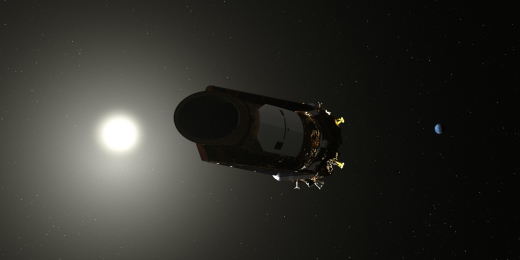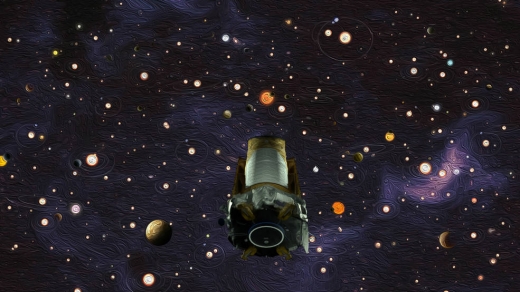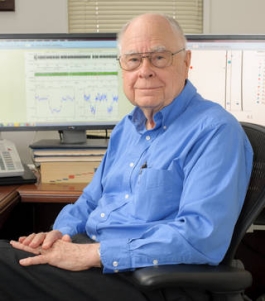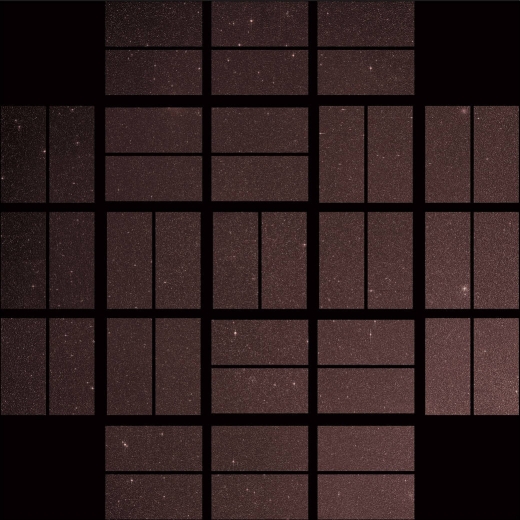The Kepler spacecraft has been with us long enough (it launched in 2009) and has revealed so much about the stars in our galaxy that its retirement — Kepler lacks the fuel for further science operations — is cause for reflection. The end of great missions always gives us pause as we consider their goals and their accomplishments, and offer up our gratitude to the many people who made the mission happen. Let’s try to back up and see things in their totality.

Image: An artist’s conception of Kepler at work. Credit: NASA/Ames/Dan Rutter.
Kepler’s job was essentially statistical, an attempt to look at as many stars as possible in a particular field of stars, so that we could gain insights into the distribution of planets there, and thus deduce something about likely conditions galaxy-wide. We didn’t know in 2009 that there was statistically at least one planet around every star, nor did we know just how diverse the worlds Kepler found, more than 2,600 of them, would be. Moreover, Kepler pushed the bounds of the possible with an ingenious extended mission.
After the mission was extended in 2012, engineers had to work around gyroscope failures to use solar photon pressure to keep the spacecraft pointed. The so-called ‘K2’ mission left the fixed view to move around the sky, studying 19 different patches of it and thus producing entirely different datasets. As with any mission, we’ve accumulated such extensive information that papers from Kepler data will be coming out for decades to come. Using the transit method to detect the passage of planets across the face of their star, Kepler’s planetary survey, originally studying over 156,000 stars, would move on through K2 to cover more than 500,000.
We have a great deal to learn as we carry Kepler discoveries forward, but it now seems likely that somewhere between 20 and 50 percent of all visible stars have rocky planets in the habitable zone of their stars. ‘Super Earths’ turned out to be the most common size of planet Kepler found, worlds between Earth and Neptune in size. Unless we find a hitherto undiscovered world deep in our outer system, we have no examples of such planets around Sol.
Interestingly, we’ve also learned how common compact planetary systems can be. Some of the Kepler systems bear more resemblance to Jupiter and its moons than planets and their host stars. KOI-961 is a case in point. About 130 light years away in Cygnus, the star is an M-dwarf about 70 percent larger than Jupiter, orbited by three small and likely rocky planets, all three of which orbit their host in less than two days.

Image: This illustration depicts NASA’s exoplanet hunter, the Kepler space telescope. The agency announced on Oct. 30, 2018, that Kepler has run out of fuel and is being retired within its current and safe orbit, away from Earth. Kepler leaves a legacy of more than 2,600 exoplanet discoveries. Credit: NASA/Wendy Stenzel/Daniel Rutter.
Another Kepler find: Kepler-11, approximately 2000 light years away, with six planets, the outermost of which is twice as close to its star as the Earth is to the Sun. In fact, the five inner planets are closer to their star than Mercury is to the Sun. The list goes on: Kepler-32 is an M-dwarf with five transiting worlds orbiting within a distance that is just one-third the size of Mercury’s orbit. We now explore how such systems form and examine multi-planet systems like TRAPPIST-1 (not a Kepler discovery) that offer planets in the habitable zone.
Kepler also discovered its share of unusual exoplanets like Kepler-10b, a world with a year that lasts less than an Earth day and a density implying it is made of iron and rock, a ‘lava world.’ K2 found a planetary object around the white dwarf WD 1145+017. Kepler-16b is the first planet discovered around a double-star system, reminiscent of Tatooine in Star Wars. Kepler-444 has five planets that are 11 billion years old. And need I mention Boyajian’s Star, whose oddly fluctuating lightcurve is indicative most likely of dust clouds but was intensely studied in terms of possible alien engineering.

“When we started conceiving this mission 35 years ago we didn’t know of a single planet outside our solar system,” said the Kepler mission’s founding principal investigator, William Borucki, now retired from NASA’s Ames Research Center in California’s Silicon Valley. “Now that we know planets are everywhere, Kepler has set us on a new course that’s full of promise for future generations to explore our galaxy.”
Image: William Borucki, principal investigator for NASA’s Kepler mission, in his office at NASA’s Ames Research Center at Moffett Field, California. June 2015. Credit: NASA Ames.
Kepler kept sending us data even as it ran low on fuel, with the latest, from Campaign 19, marking a kind of handover to TESS, the Transiting Exoplanet Survey Satellite, which launched back in April. All told, we pulled in 678 GB of science data in Kepler’s 9.6 years in space, leading thus far to 2,946 published scientific papers, with many more to come. Last night at a favorite restaurant my wife and friends joined me in a toast to the Kepler team, and the mission’s indefatigable PI William Borucki. An outstanding accomplishment all around.
To wrap this up, here’s Kepler’s ‘first light’ image from 2009.

Image: This image from NASA’s Kepler mission shows the telescope’s “first light” — a full field of view of an expansive star-rich patch of sky in the constellations Cygnus and Lyra stretching across 100 square degrees, or the equivalent of two side-by-side dips of the Big Dipper. Credit: NASA.



Kepler is an example of an outstanding NASA mission. I joined Planet Hunters and looked at thousands of light curves to pick out potential planetary candidates. It was loads of fun! The results speak for themselves. Our knowledge of extrasolar planets has expanded exponentially thanks to this one brilliant mission. Here’s a toast to Kepler from all of us!
So, how much is the telescope worth?
This sounds like an excellent candidate for a “proof of concept” grant program, “$XXX to the” group that designs and implements a retrieval system to bring Kepler back to LEO for refueling. 10X that prize to the group that designs and implements a system for in-situ refuelling.
I’ve always thought this. Would it be that difficult or expensive to launch an ion drive tug to intercept a probe, lasso or otherwise catch it, then slowly haul it back to LEO synchronous with the ISS so there could be easy multiple EVAs to repair or upgrade it? It’s not just the cost of the things in the first place and their launches, it’s their achingly long development times…. surely this would be a quick and low-cost way of getting more science done?
Yes the ISS could be the hub of a system designed for new satellites whereby refueling is standardized, fuel is accumulated and stored at the ISS and its mission is expanded to monitor and maintain satellite orbits and missions. But the ISS may not be the right platform as its own lifetime is not indefinite.
Another proof-of-concept observatory spacecraft servicing mission–a manned one, no less–that might be worthwhile would be a Falcon 9/Crew Dragon 2 visit to OAO-1, the first in the Orbiting Astronomical Observatory series, which was launched on April 8, 1966 (see: http://en.wikipedia.org/wiki/Orbiting_Astronomical_Observatory#OAO-1 ). It was injected into a perfect orbit, but its signals faded away just a few hours after launch due to a problem with its power supply–which could have been fixed by an on-site technician with just a screwdriver, and:
Its solar panels were never deployed (the batteries ran down within three days), and its optical cover door was never opened, so its multiple telescopes should be in pristine condition. Its still-folded onboard solar panels might still be usable, but if not, a new set could be carried in the Dragon spacecraft’s trunk, along with any new systems (star sensors, inertial measurement unit, etc.) that it might need in order to be restored to operational condition (one of the in-development geosynchronous satellite “life extension service modules” could be affixed to OAO-1). The Dragon spacecraft could then re-boost OAO-1 into its original circular (400 miles high, if memory serves; it hasn’t lost much altitude since launch) orbit before returning to Earth.
This is just the beginning . Kepler may be gone buts its immense data trove has only just had its surface scratched . There are still 3000 planetary candidates awaitibg confirmation and these are just the plum targets , big planets around bright nearby stars . The low lying fruit . Lots of stars in the Kepler’s many viewing fields , previously too faint for previous transit assessments now have machine learning algorithms able to pull out planets. Star clusters , previously too dense to scrutinise likewise , along with binary star systems . Asteroseismology will massively increase our knowledge of stars – along with Gaia’s precision distances – and through that accurate exoplanetary radii and masses . Know the star , know the planet .The technology has evolved enormously even since 2009 and will continue to do so. The data isn’t going anywhere , anytime soon . Unlike photographic plates it will , if stored well, last and be used centuries. All this before combination with TESS for further exoplanet science before a multiplicity of other galactic extragalactic and solar system science. Lots to look forward to.
????
Could it not be pointed one last time at Tabbys star, for old times sake.
No, it cannot. Kepler ran out of maneuvering fuel. Its radio transmitters have been shut off. But we have TESS now.
I remember my youthful excitement when the mission was being designed and launched! Much has changed since then but my sense of wonder at the discoveries remains, Kepler kept that spark alive and raised so many more questions.
I can only imagine how proud William Borucki must feel at this monumental life achievement.
Interestingly yesterday Thirty Meter Telescope was given a go ahead to continue, and new discoveries await.One ends, another begins…
And we can wait with anticipation for Plato,Ariel and others…
Farewell sweet Prince.
I understand Kepler will be parked in safe orbit, are there any Golden Record style devices for far future astronauts to decode?
Regarding Kepler’s orbit, read this excerpt from The Planetary Society’s blog piece on the satellite:
http://www.planetary.org/blogs/jason-davis/farewell-kepler.html
“Without adequate fuel reserves, the spacecraft cannot turn towards Earth to send home the precious pictures it takes while staring at the sky in search of planets crossing in front of stars. NASA has decided to retire the spacecraft by shutting down its radio transmitters, leaving it to drift slowly through space, falling farther and farther behind Earth’s elliptical track around the Sun. Every 40 years or so, Earth and Kepler will cross paths like two ships passing quietly in the night, with Kepler never coming closer than the distance between Earth and the Moon. This orbital dance could theoretically last for millions of years.”
I have no idea if Kepler carries any kind of information package such as was placed on Voyager 1 and 2, but I find it doubtful. There may be a dedication plaque along with some mementos and notes by those who worked on the satellite.
As for using very high Earth orbits to preserve information for future generations and/or visiting ETI, see here regarding another satellite:
https://centauri-dreams.org/2013/01/18/the-last-pictures-contemporary-pessimism-and-hope-for-the-future/
If the only thing wrong with it is attitude control maybe NASA should assess if its worth contracting Northrop Grumman to try to attach one of its recently developed Mission Extension Vehicles to it. https://www.youtube.com/watch?v=vJZ3xmuom0M Several “ifs” to assess technically, but perhaps its worth the money if the rest of Kepler’s systems are functional and with some anticipated life. Or has Kepler’s capability run its course due to age/sensor obsolescence and entirely superceded by TESS?
The Planetary Society has some nice tributes to Kepler on its blog here:
http://www.planetary.org/blogs/jason-davis/farewell-kepler.html
http://www.planetary.org/multimedia/planetary-radio/show/2018/1031-2018-kepler-celebration.html
Since Kepler was such a massively effective mission, wouldn’t an improved (better and/or more gyros, ability to stare at the same place even longer with less down time for data transmission, etc.) version of this telescope be called for? Love to see another different but similarly star filled region of the galaxy’s disk covered with even greater precision.
I know we’ll have Tess, nearly whole sky bright star data soon, but one result from Kepler is that finding a true Earth analog is hard. By that I mean the goldilocks trifecta, an Earth sized planet in an earthlike orbit of a sunlike star. We’ll need a beefed up version of Kepler that can stare longer to meet this goal, imho.
Bruce
This is probably naive but is the only reason fuel is an issue because the gyroscopes failed? Otherwise, I should think as long as there is sunlight, it could still point, shoot and sent back images.
My understanding is that they rotate the gyros to rotate the spacecraft in the opposite direction. Every now and then, because of losses somewhere, the gyros are spinning too fast and have to be slowed down. That gyro braking will make the spacecraft rotate, unless you use thruster fuel to counteract it.
This, from the Planetary Society’s “Farewell, Kepler” article should answer your question:
“NASA’s groundbreaking Kepler space telescope mission, which revolutionized our understanding of planets orbiting other stars, has come to an end, the agency announced today.
On 11 October, NASA’s Deep Space Network turned its gaze to a spot 170 million kilometers behind Earth in our path around the Sun. There, Kepler turned toward Earth and transmitted the precious data it recently gathered while staring at a patch of sky in the constellation Aquarius. The one-way light travel time between Kepler and Earth is 9.3 minutes.
After that, Kepler tried to get back to work. But on 23 October, NASA learned that the spacecraft had fallen asleep, a side effect of the fact that it was out of fuel. Launched in 2009 on a 3.5-year mission to get a statistical sense of the number of exoplanets in the Milky Way, the telescope has operated for 9 years, thanks to austere fuel use by its mission team.
Without adequate fuel reserves, the spacecraft cannot turn towards Earth to send home the precious pictures it takes while staring at the sky in search of planets crossing in front of stars. NASA has decided to retire the spacecraft by shutting down its radio transmitters, leaving it to drift slowly through space, falling farther and farther behind Earth’s elliptical track around the Sun. Every 40 years or so, Earth and Kepler will cross paths like two ships passing quietly in the night, with Kepler never coming closer than the distance between Earth and the Moon. This orbital dance could theoretically last for millions of years.”
I had not known that Kepler’s mission controllers–like Mariner 10’s–had resorted, successfully, to extending its useful life by utilizing solar photon pressure for attitude control. This suggests a possible way for a follow-on spacecraft to remain usable indefinitely:
Solar sails are usually thought of in connection with translational motion; that is, propelling itself (and its attached spacecraft, payload, or cargo) somewhere. But smaller, movable sails could provide *rotational* (i.e., attitude control) motions–and also ^prevent^ such motions, to provide precision pointing–about the spacecraft’s pitch, yaw, and roll axes. (Many of the non-spinning, boom-supported, square and triangular solar sail spacecraft designs include such smaller attitude control sails, called vanes, which are mounted at the corners of the larger main sails; the vanes can be tilted and rotated in order to control the vehicles in pitch, yaw, and roll.) Also:
While such observatory spacecraft could, like Kepler, use either mechanical (spinning) gyroscopes or laser ring gyroscopes and accelerometers in an inertial measurement unit (IMU) for precision pointing, they could also employ (as a back-up to the IMU, or as a means of re-setting them, or both) a stellar navigation system, which would use three or more stars as reference points. This type of stellar-inertial guidance system was used at least as far back as the 1950s, when the Northrop SM-62 Snark ICCM (Intercontinental Cruise Missile) utilized one. An observatory spacecraft’s guidance problem is significantly simpler than that of a cruise missile, as the spacecraft does not maneuver along a flight path once it reaches its mission orbit; it only needs to point at its observation targets.
Kepler is perhaps the most cost effective of all NASA’s science missions. I had the pleasure of meeting Dr. Borucki years before the mission was approved (as is well known, that process was not easy and involved several steps, as lots of old f***s at NASA and elsewhere thought his idea would never work while lots of younger (then!) folk thought it was an absolute no-brainer!). I can point to what I believe is one major mistake the mission team made though: Roughly one year of science was lost while converting from the original mission to K2. This was completely avoidable and should have been planned for beforehand as the likely cause of failure (too many gyros lost) was extremely well known at the time.
Did Kepler use a significant amount of fuel during that one-year hiatus, then?
An Improvement of Kepler’s cabilities is what is needed.
The one thing Kepler wasn’t able to do was find Twins of Earth in
around F, G and K type stars in habitable zones. but it gave us
a leg up on WHICH, stars are great candidates for a follow up mission.
Is this a matter of a larger telescope aperture and detector sensitivity
or are stars too noisy at the 600-2000Ly and another method is needed?
JPL News | November 16, 2018
Kepler Telescope Bids ‘Goodnight’ with Final Commands
On the evening of Thursday, Nov. 15, NASA’s Kepler space telescope received its final set of commands to disconnect communications with Earth. The “goodnight” commands finalize the spacecraft’s transition into retirement, which began on Oct. 30 with NASA’s announcement that Kepler had run out of fuel and could no longer conduct science.
Coincidentally, Kepler’s “goodnight” falls on the same date as the 388-year anniversary of the death of its namesake, German astronomer Johannes Kepler, who discovered the laws of planetary motion and passed away on Nov. 15, 1630.
https://www.jpl.nasa.gov/news/news.php?feature=7284
The last call…
https://www.spaceflightinsider.com/missions/space-observatories/last-kepler-images-capture-numerous-planetary-systems/